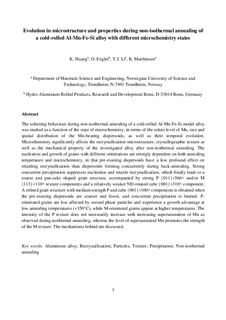| dc.contributor.author | Huang, Ke | |
| dc.contributor.author | Engler, Olaf | |
| dc.contributor.author | Li, Yanjun | |
| dc.contributor.author | Marthinsen, Knut | |
| dc.date.accessioned | 2017-11-30T12:29:06Z | |
| dc.date.available | 2017-11-30T12:29:06Z | |
| dc.date.created | 2015-01-25T23:47:07Z | |
| dc.date.issued | 2015 | |
| dc.identifier.citation | Materials Science & Engineering: A. 2015, 628 216-229. | nb_NO |
| dc.identifier.issn | 0921-5093 | |
| dc.identifier.uri | http://hdl.handle.net/11250/2468649 | |
| dc.description.abstract | The softening behaviour during non-isothermal annealing of a cold-rolled Al–Mn–Fe–Si model alloy was studied as a function of the state of microchemistry, in terms of the solute level of Mn, size and spatial distribution of the Mn-bearing dispersoids, as well as their temporal evolution. Microchemistry significantly affects the recrystallization microstructure, crystallographic texture as well as the mechanical property of the investigated alloy after non-isothermal annealing. The nucleation and growth of grains with different orientations are strongly dependent on both annealing temperature and microchemistry, in that pre-existing dispersoids have a less profound effect on retarding recrystallization than dispersoids forming concurrently during back-annealing. Strong concurrent precipitation suppresses nucleation and retards recrystallization, which finally leads to a coarse and pan-cake shaped grain structure, accompanied by strong P {011}〈566〉 and/or M {113}〈110〉 texture components and a relatively weaker ND-rotated cube {001}〈310〉 component. A refined grain structure with medium strength P and cube {001}〈100〉 components is obtained when the pre-existing dispersoids are coarser and fewer, and concurrent precipitation is limited. P-oriented grains are less affected by second phase particles and experience a growth advantage at low annealing temperatures (<350 °C), while M-oriented grains appear at higher temperatures. The intensity of the P texture does not necessarily increase with increasing supersaturation of Mn as observed during isothermal annealing, whereas the level of supersaturated Mn promotes the strength of the M texture. The mechanisms behind are discussed. | nb_NO |
| dc.language.iso | eng | nb_NO |
| dc.publisher | Elsevier | nb_NO |
| dc.title | Evolution in microstructure and properties during non-isothermal annealing of a cold-rolled Al-Mn-Fe-Si alloy with different microchemistry states | nb_NO |
| dc.type | Journal article | nb_NO |
| dc.description.version | submittedVersion | nb_NO |
| dc.source.pagenumber | 216-229 | nb_NO |
| dc.source.volume | 628 | nb_NO |
| dc.source.journal | Materials Science & Engineering: A | nb_NO |
| dc.identifier.doi | 10.1016/j.msea.2015.01.064 | |
| dc.identifier.cristin | 1206747 | |
| dc.relation.project | Norges forskningsråd: 193179 | nb_NO |
| dc.description.localcode | This is a submitted manuscript of an article published by Elsevier Ltd in Materials Science & Engineering: A, 30 January 2015. | nb_NO |
| cristin.unitcode | 194,66,35,0 | |
| cristin.unitname | Institutt for materialteknologi | |
| cristin.ispublished | true | |
| cristin.fulltext | preprint | |
| cristin.qualitycode | 2 | |
